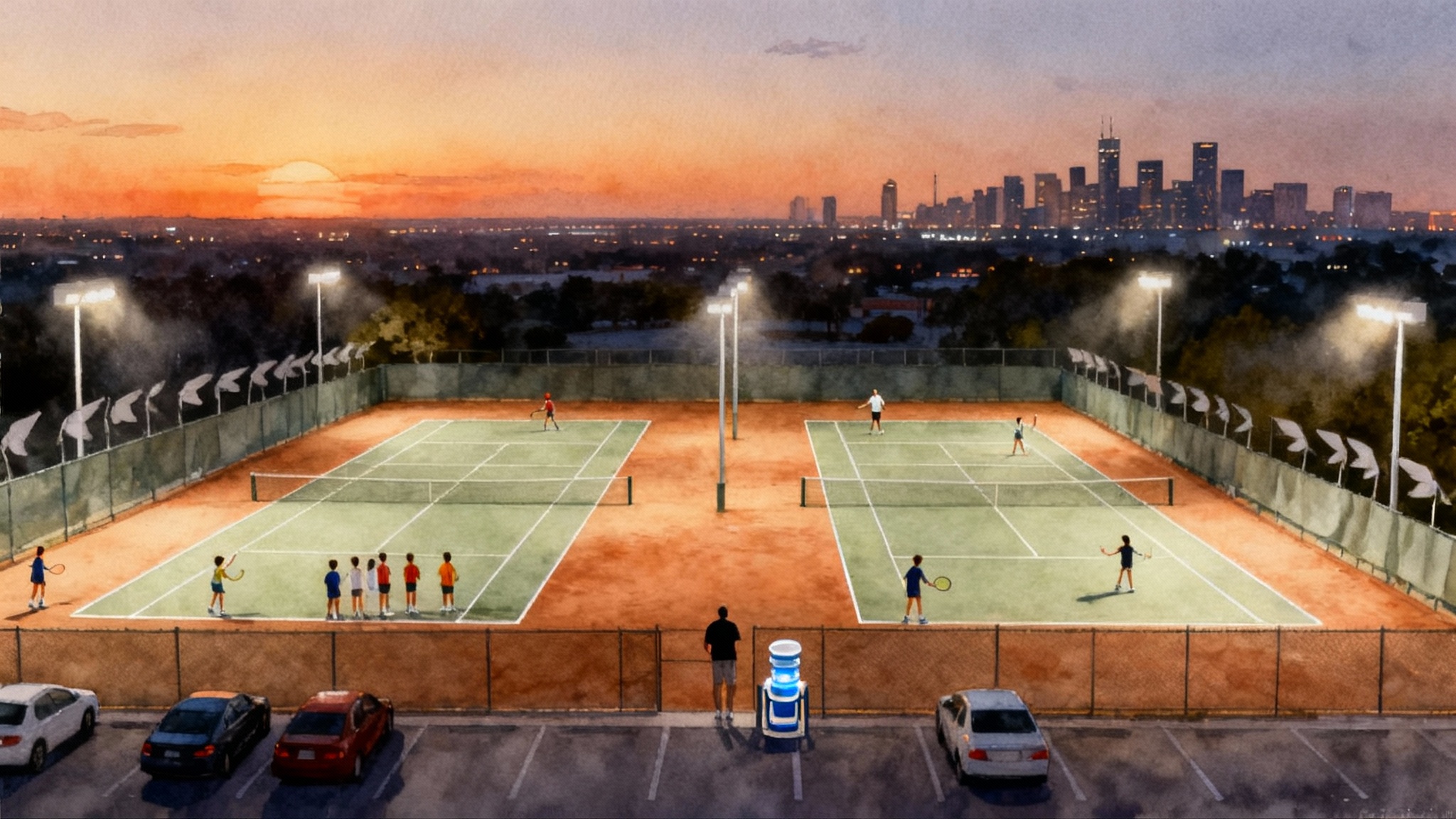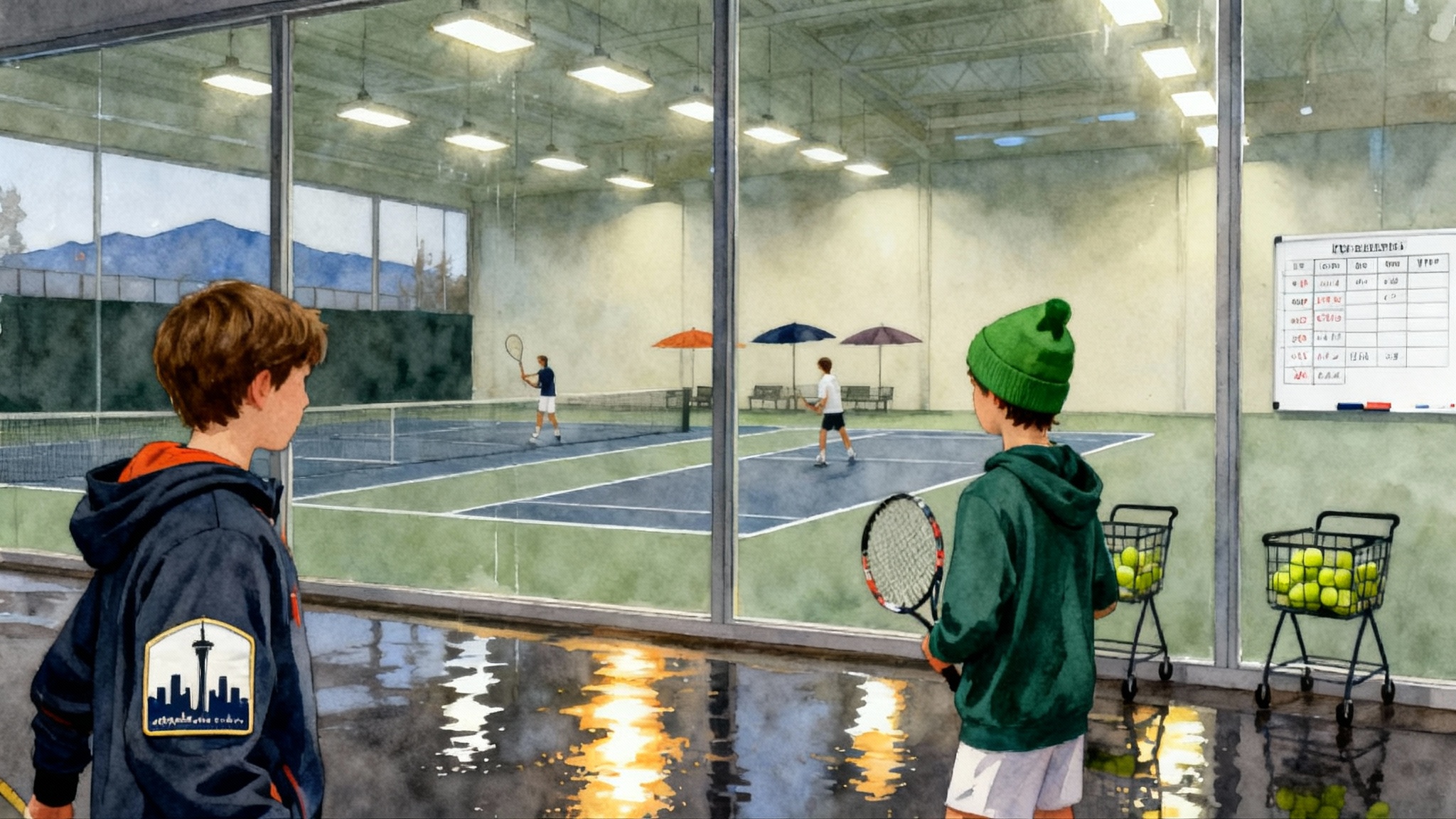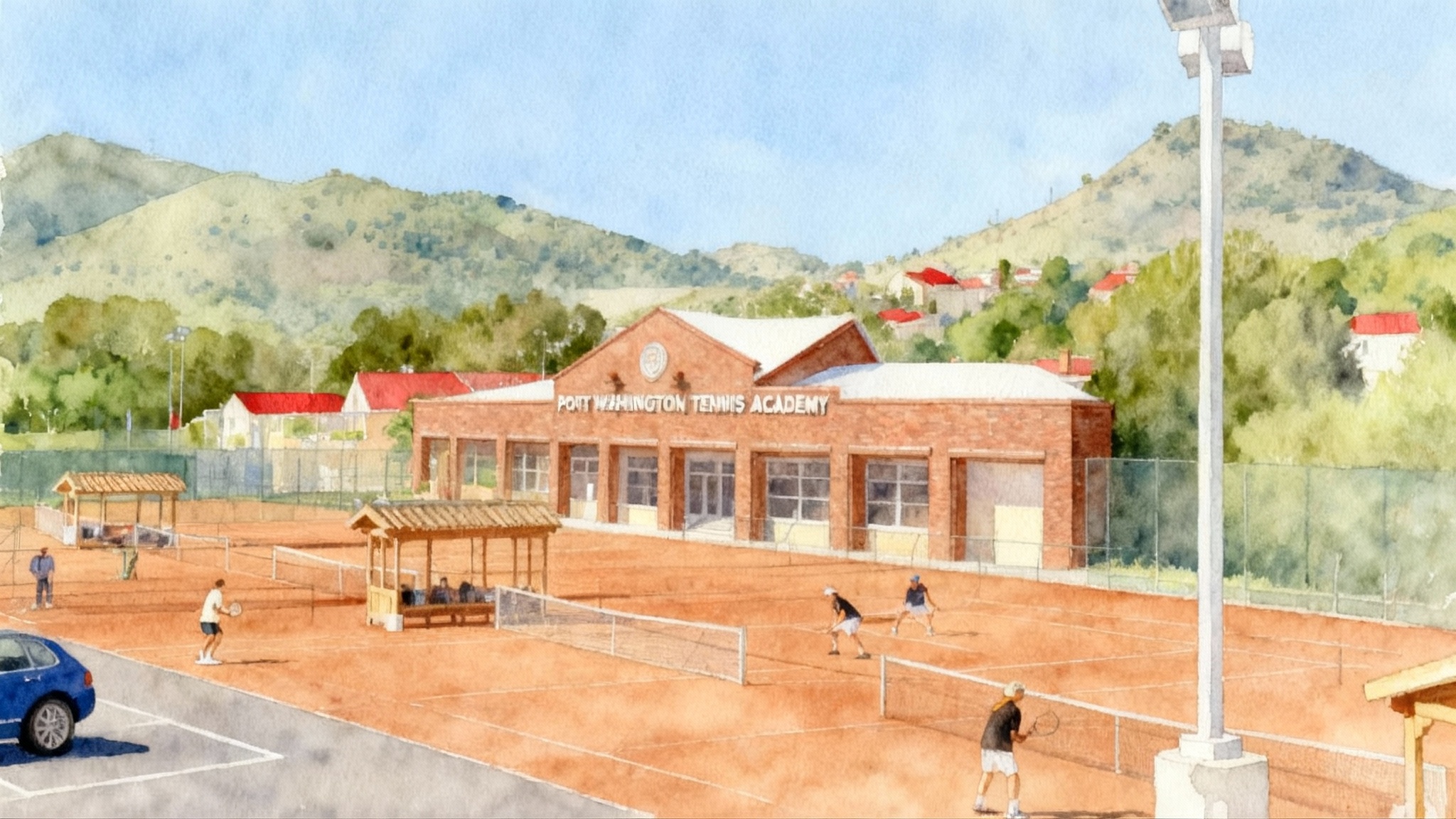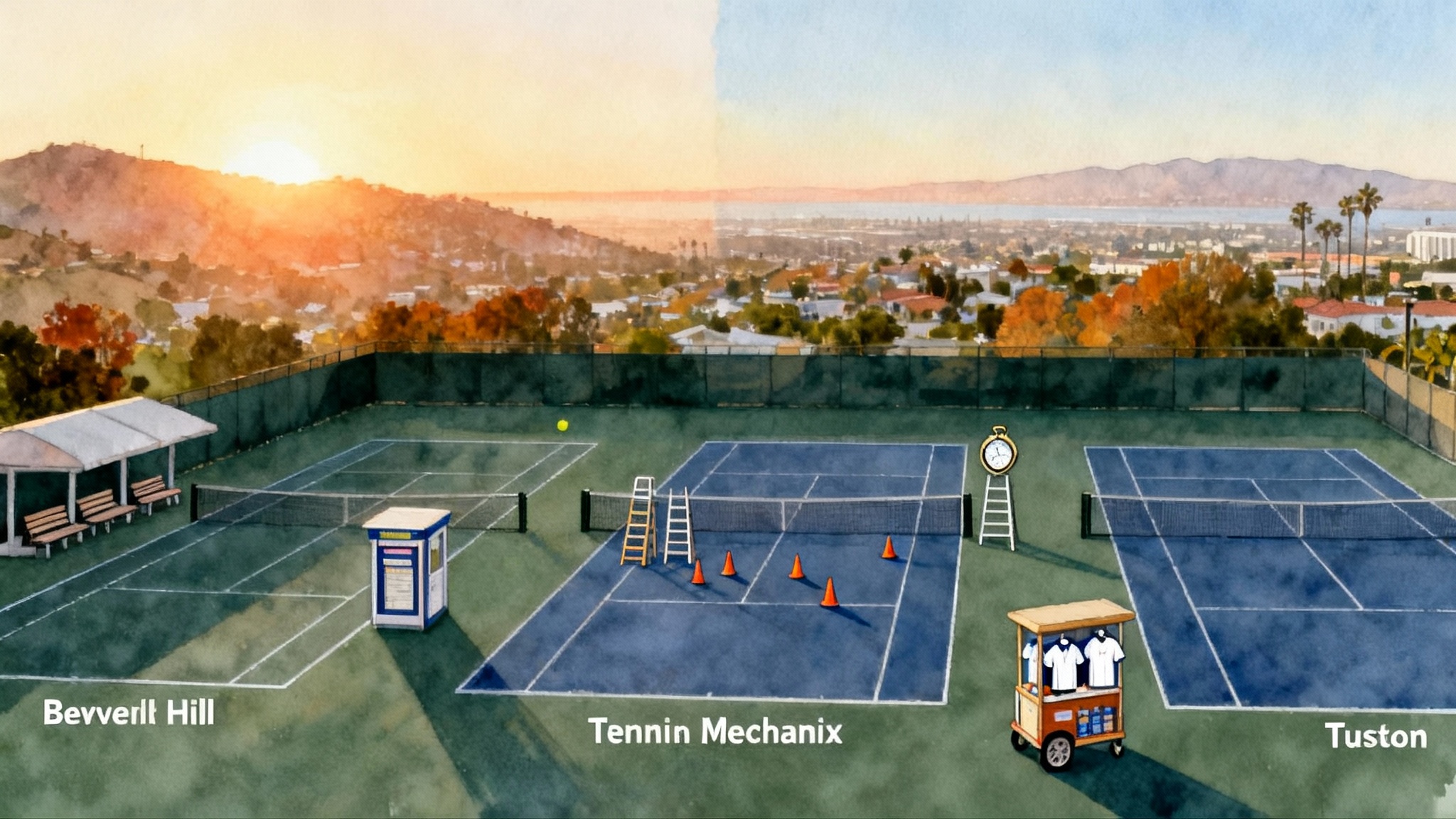Best Texas Tennis Academies 2025-2026: A Parent’s Guide
A data-driven, city-by-city guide to junior tennis in Texas for 2025-2026. Compare Dallas–Fort Worth, Houston, Austin, and San Antonio on coaching, training volume, UTR match play, surfaces, schooling, pricing, and college placement.

Why Texas is a uniquely strong junior tennis market in 2025-2026
Texas sits at the crossroads of year-round outdoor tennis, a deep tournament calendar, and a large pool of high school and college programs. If you are choosing a training home for your player this school year, you will hear one concept over and over: UTR, the Universal Tennis Rating. It is the currency of most match-play decisions and scrimmage ladders. Before you compare academies, make sure you understand how UTR is calculated. That single metric heavily shapes where your child will be grouped and what matches they will get.
If you are benchmarking beyond Texas, compare this guide with our regional roundups: Florida academies 2025-2026 guide, NY and NJ academies guide, and Bay Area academies guide.
Texas also offers variety across four major hubs, each with a distinct flavor:
- Dallas–Fort Worth: high density of clubs and frequent UTR match days
- Houston: humidity training and more clay at private clubs
- Austin: smaller, academic-friendly setups with strong tech and fitness integration
- San Antonio and the Hill Country: quieter environments and the state’s best-known boarding option nearby
The best academy for your family is not the one with the biggest name. It is the one that fits your player’s age, current UTR, school plan, and commute reality.
How we compare academies
When families ask us to shortlist programs, we score each option on seven practical criteria:
- Coaching credentials
- Former college players and coaches on staff, especially with recent experience placing juniors
- Coach-to-court ratios during drilling and point play
- Use of video and match charting, not just baskets and ball-feeding
- Training volume and structure
- Weekly hours across on-court drilling, live ball, and match play
- Scheduled fitness that includes movement, strength, and injury prevention
- Individualized blocks for serve and return rather than generic stations
- UTR-based match play
- Regular in-house ladders and verified UTR events
- Intentional matchup design so players get 50 to 70 percent win probability, which is best for growth
- Surfaces and facilities
- Access to quality hard courts for speed and timing
- Clay availability for defense, point construction, and lower joint load on high-volume weeks
- School model
- After-school groups for public or private school students
- Homeschool or hybrid day programs with built-in study hall
- Boarding availability and who oversees academics
- Price transparency
- Public price sheets for group training, fitness, private lessons, and tournament coaching
- Clear refund, rain, and makeup policies
- College placement
- Recent alumni list, contactable references, and a transparent role in the placement process
- Staffer who handles video, emails to coaches, and timelines for the National Letter of Intent
What “good” looks like by the numbers
These are ranges we see across Texas programs that consistently progress players:
- Weekly hours for after-school performance tracks: 10 to 14 on-court, plus 2 to 3 of fitness
- Full-time homeschool tracks: 16 to 22 on-court, plus 3 to 5 of fitness and recovery
- Coach to player ratios: 1 to 4 for technical blocks, 1 to 6 for live ball
- Match play: 2 to 6 verified UTR matches most months; higher in Dallas–Fort Worth and Houston
- Surfaces: Texas is primarily hard court. Clay courts are a competitive advantage during heavy blocks and in Houston’s summer heat.
Use these ranges as a quick filter. If an academy cannot meet the hours or match counts your player needs, no brand halo will fix that gap.
City-by-city snapshot
Dallas–Fort Worth
- Coaching depth: The region has the broadest roster of former college players and traveling coaches, especially on the north side. You will find specialists for serve mechanics, doubles patterns, and return footwork.
- Training volume: After-school tracks typically run 5 days per week with 2 to 3 hours per day. Homeschool options run mid-day blocks and add morning fitness.
- UTR match play: Highest frequency in the state. Expect weekly ladders and several verified events per month within a 45-minute drive.
- Surfaces: Mostly hard courts. Limited clay, but a few clubs maintain soft courts for summer blocks.
- Schooling: Many hybrid day programs that coordinate with online coursework. Boarding is rare inside the metroplex.
- Price transparency: Mixed. Larger programs often publish group prices; travel coaching and fitness add-ons may be quoted after evaluation.
- College placement: Deep network into Division I, Division II, Division III, and National Association of Intercollegiate Athletics. Doubles-focused players often thrive here due to partner options.
Best for: Players who want maximum match volume, a variety of hitting partners, and many local tournament choices.
Watchouts: Traffic can turn a 25-minute drive into 55. Plan realistic commute windows if your player finishes school at 3:30 p.m.
Houston
- Coaching depth: Strong technical coaching with a history of developing heavy ball hitters and resilient competitors conditioned by heat and humidity.
- Training volume: Similar to Dallas–Fort Worth, with more scheduled fitness and hydration protocols during summer.
- UTR match play: Robust. Verified events most weekends across the metro area and reliable in-house match days.
- Surfaces: More clay than other metros at private clubs. Parents seeking joint-friendly volume should ask specifically about clay access.
- Schooling: Several homeschool tracks and academic partnerships. Boarding is uncommon in the metro area.
- Price transparency: Improving. Many programs share tiered pricing and fitness add-ons in writing.
- College placement: Consistent pipelines to state universities and a handful of elite academic programs for strong students.
Best for: Players who benefit from humidity training, need clay as a load-management tool, and want competitive depth without flying.
Watchouts: Afternoon thunderstorms can compress schedules. Ask about indoor backup or guaranteed makeups.
Austin
- Coaching depth: Smaller programs with hands-on technical work and modern performance tools like video, force plates, and mobility screening.
- Training volume: After-school tracks tend to be slightly smaller groups; homeschool day programs are well organized with dedicated study hall.
- UTR match play: Steady but less dense than Dallas–Fort Worth and Houston. Many families pair Austin training with weekend travel to those cities for extra verified matches.
- Surfaces: Mostly hard courts. Limited clay, often oversubscribed during summer.
- Schooling: Some of the most structured homeschool and hybrid options, with clear academic point people.
- Price transparency: Generally clear. Many programs publish price sheets and spell out tournament coaching fees.
- College placement: Strong at the high academic end for organized families who engage early on filming and outreach.
Best for: Families who value individualized attention, predictable routines, and collaborative academic planning.
Watchouts: Fewer clay courts and fewer weekly UTR events. Budget for periodic travel to nearby metros to boost match counts.
San Antonio and the Hill Country
- Coaching depth: A quieter scene with focused technical coaches and strong point-construction teaching.
- Training volume: After-school is consistent. The area’s standout is access to a true boarding environment in the Hill Country, which some families use for summer or gap semesters.
- UTR match play: Solid, with many families traveling to Austin or Houston for additional verified events.
- Surfaces: A healthier mix of hard and clay relative to the city size.
- Schooling: Traditional after-school plus boarding nearby where academics are overseen on site.
- Price transparency: Clear for group training, with boarding packages quoted case by case.
- College placement: Good track record for players who need structure and fewer urban distractions.
Best for: Players who thrive in smaller settings, want boarding or semi-boarding structure, and prefer access to clay.
Watchouts: You may drive farther for frequent UTR events and higher-level sparring.
Picks by player profile
Below are practical fits by profile. Use them to narrow your shortlist before you book evaluations.
10 and under pathway
What to prioritize
- Red, orange, green progression with age-appropriate court sizes and balls
- Coach-to-court ratios near 1 to 4 for early technical blocks
- Weekly fun match days, not just feeding drills
- Parent education nights so you understand rules and equipment
City fits
- Dallas–Fort Worth and Houston for depth of 10 and under groups and frequent festival-style events
- Austin for small, attentive groups with strong communication to parents
- San Antonio for calm environments and more time per child
Rising UTR 6 to 9
What to prioritize
- 12 to 16 weekly training hours with two to three days of targeted fitness
- Two verified UTR matches each weekend or the equivalent in in-house ladders
- Pattern work: plus-one forehands, backhand neutralizing, first strike on second serve
- Serve and return filmed monthly with progress benchmarks
City fits
- Dallas–Fort Worth for the most weekly matches without flying
- Houston for clay-heavy weeks that build defense and patience
- Austin for detailed technical adjustments and structured academics
College-prep track
What to prioritize
- 16 to 22 on-court hours with periodized fitness and recovery
- Staffer who manages video reels, email templates, and call prep for coaches
- Doubles reps for lineup versatility
- Academic advising aligned to recruiting timelines and the National Letter of Intent calendar
City fits
- Dallas–Fort Worth for partner depth and broad college networks
- Houston for heavy summer blocks with clay and heat conditioning
- Austin for strong academic coordination
- San Antonio and Hill Country for boarding structure if independence and routine are the goal
If you are new to the process, the United States Tennis Association has a useful overview of timelines and checklists in its college recruiting guide.
Tryout and intake windows you can plan around
Most Texas academies follow a predictable rhythm:
- Late spring to mid summer, May through August: evaluations and tryouts for fall semester groups
- Early winter, December and January: midyear intakes for homeschool tracks and rebalancing of after-school groups
- Rolling, monthly: assessments for private lesson pairings, doubles partners, and internal ladders
How to approach tryouts
- Book a two-day evaluation if possible. Day one for drilling and fitness, day two for live ball and match play.
- Ask to see a sample weekly schedule and lesson plan. Look for a balance of technique, patterns, points, and serves.
- Bring recent match film and a short player profile with UTR, goals, and current schedule. You will get better placement on day one.
Scholarship and discount playbook
Financial help exists, but families often ask too late. Start 8 to 12 weeks before your intended start date.
What to ask for
- Need-based aid for full-time tracks
- Merit discounts tied to verified UTR or sectional rankings
- Work-trade such as court setup or weekend tournament support
- Sibling discounts and multi-month prepay savings
What to prepare
- A clear weekly plan showing you can attend 90 percent of sessions
- UTR profile link and last 10 verified scores
- One coach reference who will return calls in 24 hours
Key principle: show commitment in writing. Programs invest in families who demonstrate reliability.
Travel logistics that make or break your week
Airports
- Dallas–Fort Worth: DFW and Love Field
- Houston: George Bush Intercontinental and Hobby
- Austin: Austin–Bergstrom
- San Antonio: San Antonio International
Commute math
- Put practice start and end times into your phone for three random weekdays. Map from home and school. Add 15 minutes to whatever the app says. If the round-trip exceeds 90 minutes more than two days per week, consider a closer program or a carpool.
Tournament corridors
- Dallas–Fort Worth and Houston can fill most weekends inside a one-hour drive
- Austin and San Antonio families should budget one out-of-metro trip per month to keep verified match counts on track
Pro tip: write your family’s tennis operating system. Monday is serves and fitness, Tuesday is live ball, Wednesday is match play, Thursday is doubles patterns, Friday is recovery and film. Do this on paper. It keeps you from over-committing on travel and skipping recovery.
The five-question on-site visit
When you tour an academy, ask the director or lead coach these exact questions:
- Where will my child start next week, and what specifically must they show to move up a training tier?
- How many verified UTR matches will you help us create each month without flights?
- Who is the one staffer who texts me after bad losses and tells me what we learned and what we change next week?
- What is your coach-to-court ratio during serves and returns, and who runs that block?
- Show me two alumni from the last two years who match my child’s profile and where they landed.
If answers are vague or the staff cannot give an example, trust that signal.
A simple 30-60-90 day plan
- Days 1 to 30: confirm technical priorities on two strokes, schedule two verified UTR matches, and build a recovery routine
- Days 31 to 60: raise weekly live-ball volume by 20 percent, add a doubles session, and schedule one tournament with targeted opponents
- Days 61 to 90: reduce private lessons by one if the player can self-correct on film, then reallocate that hour to match play
Run this plan, then decide whether to renew, change tiers, or switch academies.
Clear city picks by profile
- For 10 and under, choose Dallas–Fort Worth or Houston for group depth and frequent playful competition. If your child thrives on quieter courts, visit Austin or San Antonio where groups are smaller.
- For rising UTR 6 to 9, Dallas–Fort Worth delivers the most verified match volume, Houston adds clay and heat conditioning that travel well, and Austin offers surgical technical work. Blend San Antonio weekends if you want clay without big city traffic.
- For college-prep, choose the city that solves your biggest constraint. Need partners and exposure, pick Dallas–Fort Worth. Need clay and conditioning blocks, pick Houston. Need academic scaffolding, pick Austin. Need boarding structure, explore the Hill Country outside San Antonio.
Final checklist before you sign
- Written schedule and price sheet including travel coaching and makeups
- Named point person for weekly feedback
- Measured goals tied to UTR, not just “improve forehand”
- Commute plan that survives rain delays and homework spikes
- Trial month on paper, then a semester commitment
Conclusion
Texas gives parents something rare in junior tennis. You can choose from four distinct ecosystems within a morning’s drive, each strong enough to develop competitors for college and beyond. Start with your player’s profile, then pick the city that solves your biggest constraint. Demand clarity on coaching roles, training volume, and UTR match play. Plan your commute and your calendar before you sign. Do those simple things and Texas will feel less like a maze and more like a runway your player can trust.








